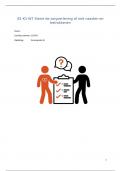Samenvatting
Behavioural and Experimental Finance Summary and Assignments (2020)
This summary contains everthing you need to know about the course Behavioural and Experimental Finance. It starts of with a summary of the entire course as thought in the lectures, and it gives all Ernie assignments including answers as well.
[Meer zien]













